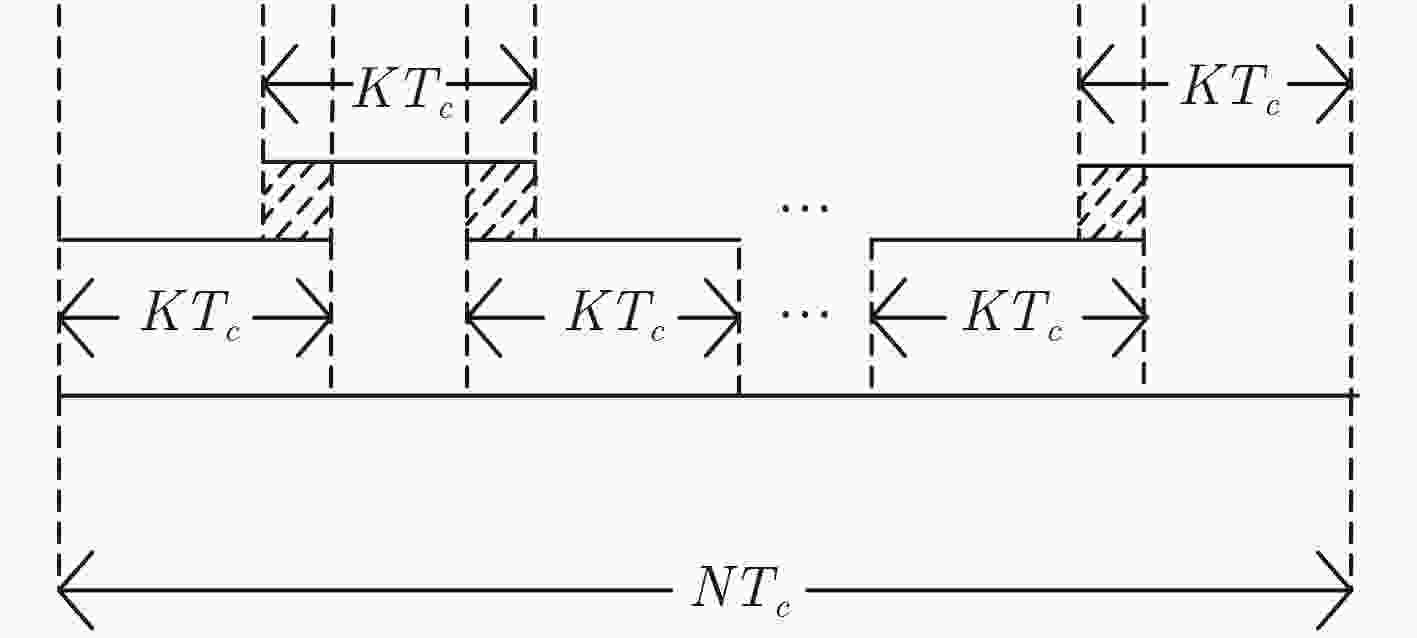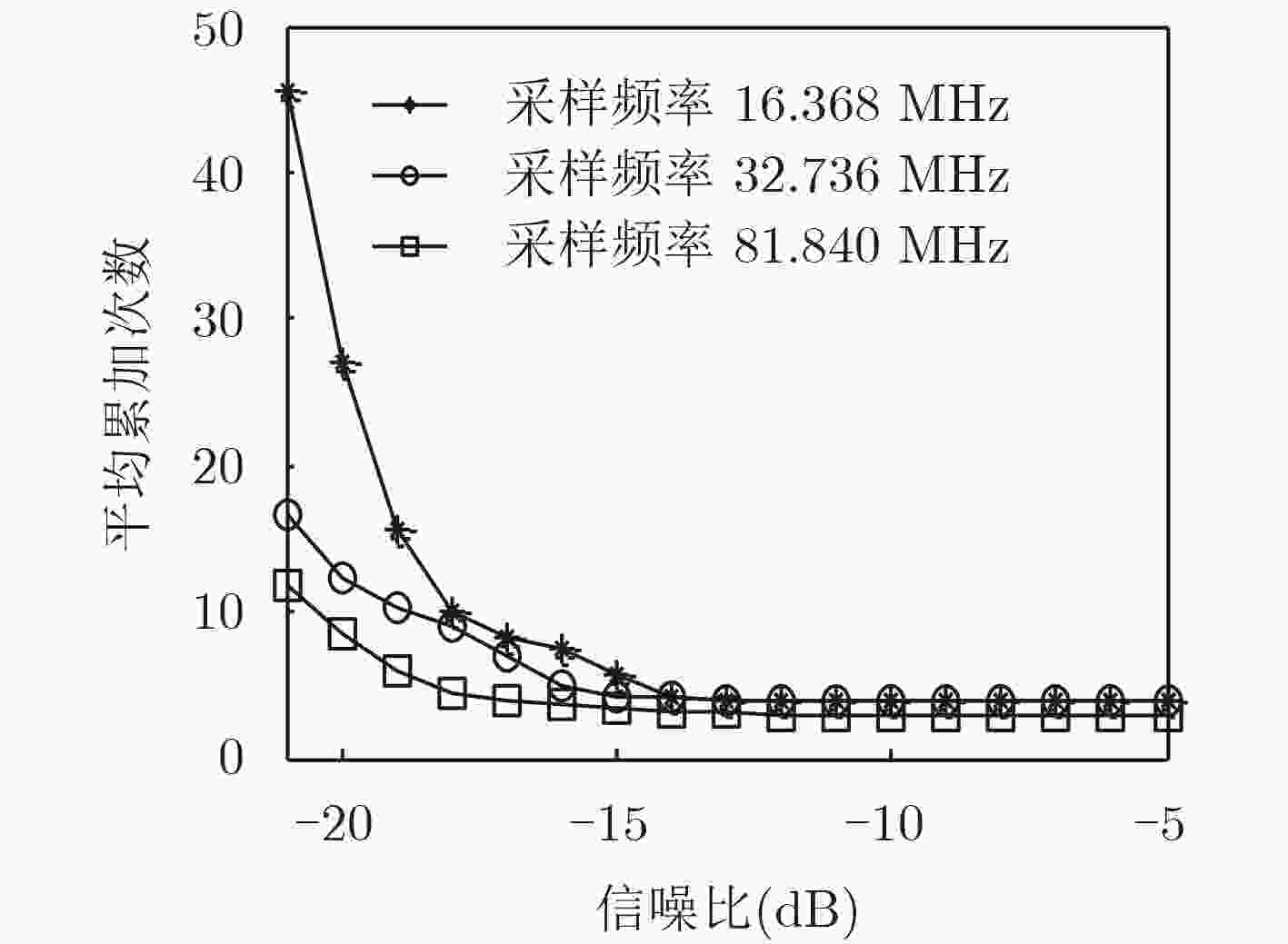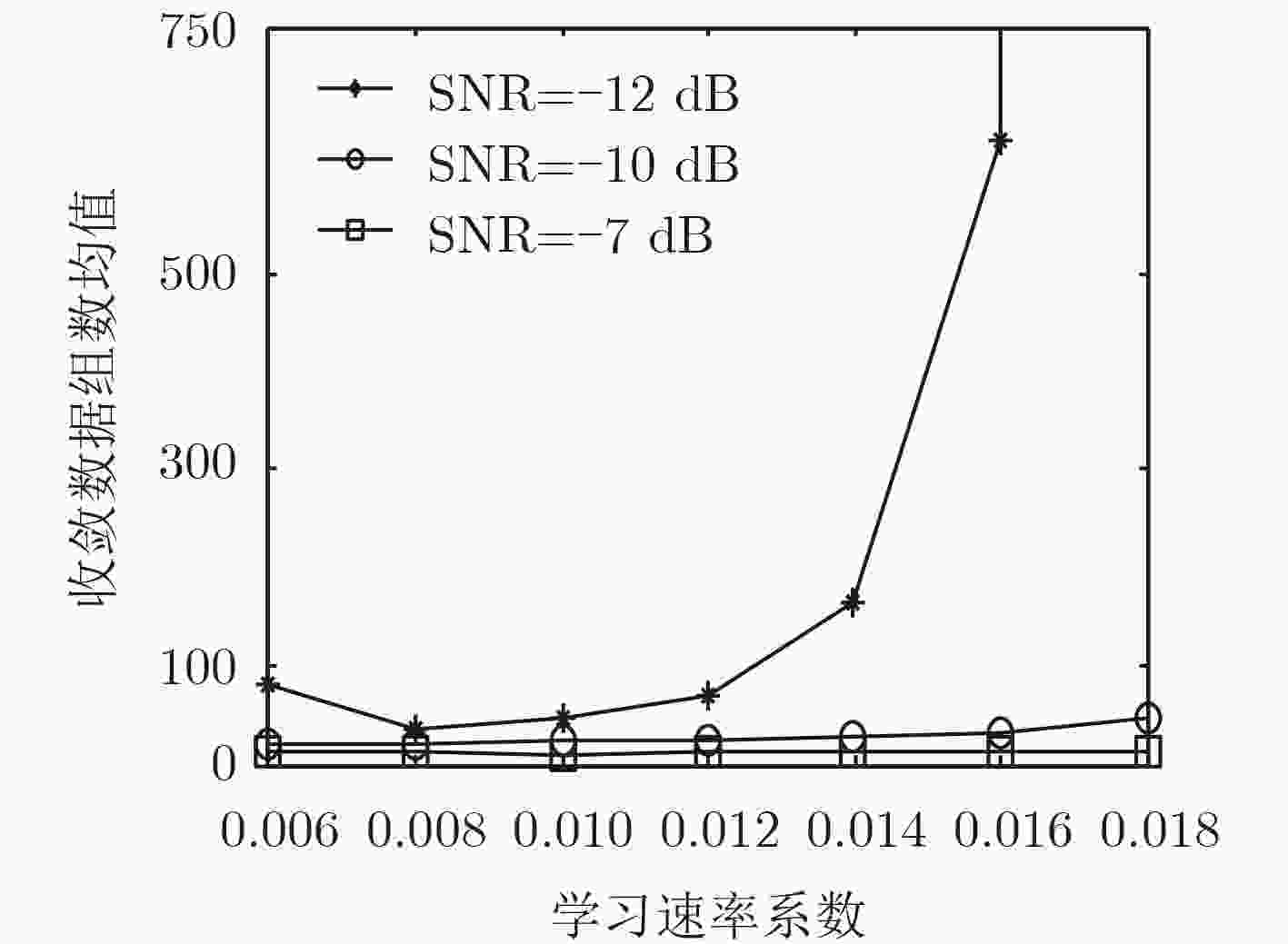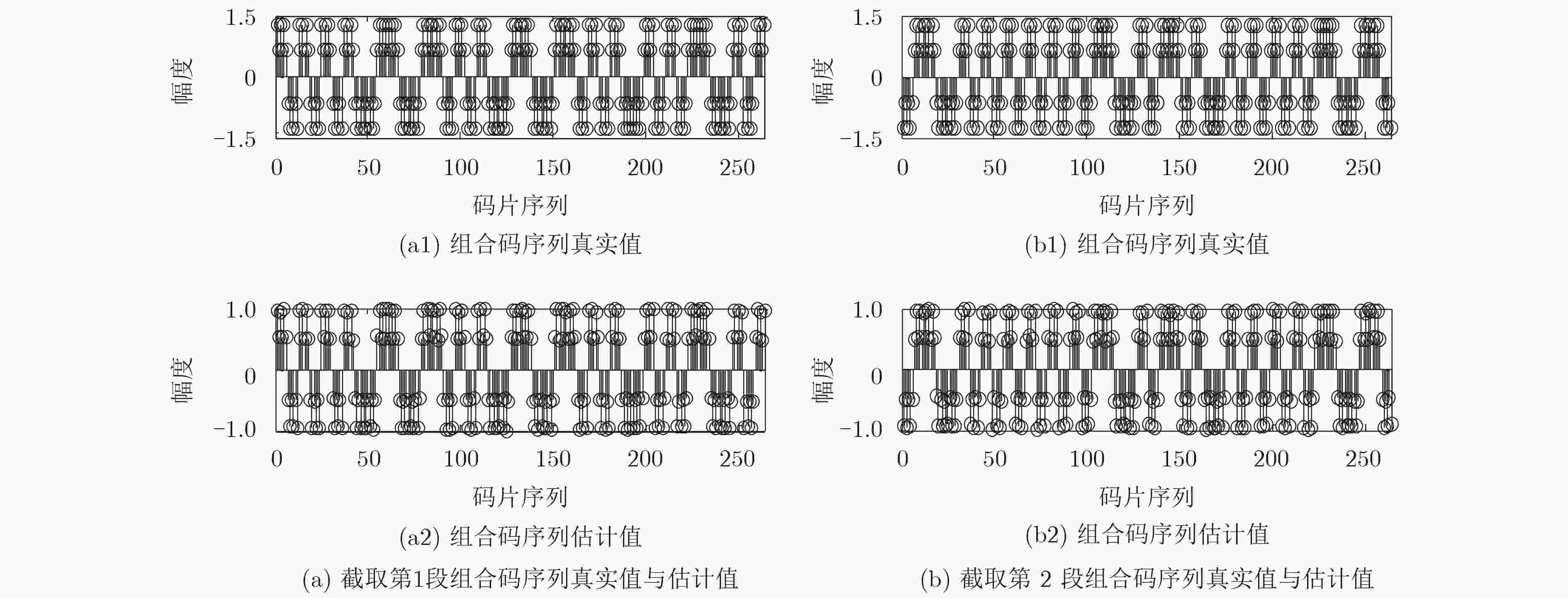Blind Estimation of the Pseudo Code Period and Combination Code Sequence for Composite Binary Offset Carrier Signal
-
摘要:
针对在非协作通信以及低信噪比下组合二进制偏移载波(CBOC)信号伪码周期和组合码序列较难估计的问题,该文提出了2次谱算法与基于径向基函数(RBF)神经网络算法。对输入信号进行2次功率谱计算,可以得到CBOC信号的伪码周期。在此基础上,首先对接收的1周期组合码序列进行重叠分段,其次优化筛选出学习系数,对每段数据向量作为RBF神经网络的输入信号并进行有监督地调节,最后对每段数据向量多次输入并反复训练权值向量就可以恢复原组合码序列。仿真结果表明,利用2次谱可以在低信噪比下估计出伪码周期;在误码率低于1%的情况下,所提出的RBF神经网络相比于反向传播(BP)神经网络与Sanger神经网络,信噪比分别提高1 dB和3 dB,并且在同等条件下所需的数据组数较少。
-
关键词:
- 组合二进制偏移载波信号 /
- 组合码序列 /
- 2次功率谱 /
- 伪码周期 /
- 径向基神经网络
Abstract:For the problems of the Composite Binary Offset Carrier (CBOC) signal pseudo code period and combination code sequence are difficult to estimate in a non-cooperative context, two blind methods are proposed based on power spectrum reprocessing and Radial Basis Function (RBF) neural networks. It can get the CBOC pseudo code period through two power spectrum calculations. Firstly, the received one pseudo code period is overlapped segmentation based on the estimated pseudo code period. Secondly, the learning coefficient is optimized selection and each segment of date vector as an input signal to the RBF neural networks to supervised adjustment. Finally, through the continuous input signal, it can restore the original combination code sequence according to the convergent weight vectors. Simulation results show that the pseudo code period can be estimated using the secondary power spectrum under low Signal-to-Noise Ratio (SNR). Compared with the Back Propagation (BP) neural networks and the Sanger neural networks, the proposed RBF neural networks improve the SNR by 1 dB and 3 dB respectively and the number of data groups required is less through RBF neural networks under the same condition.
-
表 1 E1频段扩频码特性
E1信号分量 扩频码周期
(ms)扩频码码长 扩频码速率
(Mbps)主码长度 辅助码长度 数据通道 4 4092 无辅助码 1.023 导频通道 100 4092 25 1.023 -
谢钢. 全球导航卫星系统原理—GPS、格洛纳斯和伽利略系统[M]. 北京: 电子工业出版社, 2013: 88–97.XIE Gang. Principles of GNSS: GPS, GLONASS and Galileo[M]. Beijing: Publishing House of Electronics Industry, 2013: 88–97. PAUN A F and CASANDRA A R. Analysis of the performance of an acquisition algorithm for Galileo E1 signals[C]. Proceedings of the International Conference on Communications, Bucharest, Romania, 2016: 469–472. doi: 10.1109/ICComm.2016.7528262. UNION E. European GNSS(Galileo) Open Service: Signal in Space: Interface Control Document[M]. Luxembourg: Publications Office of the European Union, 2010: 8–171. DENG Zhongliang, XI Yue, JIAO Jichao, et al. Unambiguous acquisition for Galileo E1 OS signal based on delay-and-multiply[J]. Telkomnika, 2014, 12(4): 950–962 doi: 10.12928/TELKOMNIKA.v12i4.530 张天骐, 江晓磊, 赵军桃, 等. 二进制偏移载波及其衍生信号的通用无模糊捕获算法[J]. 电子与信息学报, 2017, 39(2): 451–458 doi: 10.11999/JEIT160351ZHANG Tianqi, JIANG Xiaolei, ZHAO Juntao, et al. Unambiguous general acquisition for binary offset carrier and its derivative signals[J]. Journal of Electronics &Information Technology, 2017, 39(2): 451–458 doi: 10.11999/JEIT160351 陈昌川, 周杨, 张天骐. TDDM-BOC信号组合码序列及信息序列盲估计[J]. 电子与信息学报, 2016, 38(11): 2760–2766 doi: 10.11999/JEIT160042CHEN Changchuan, ZHOU Yang, and ZHANG Tianqi. Blind estimation of the combination code sequence and information sequence for TDDM-BOC signal[J]. Journal of Electronics &Information Technology, 2016, 38(11): 2760–2766 doi: 10.11999/JEIT160042 钱博, 田浩明, 冯永新, 等. BOC调制信号相关检测算法[J]. 火力指挥与控制, 2011, 36(4): 22–25QIAN Bo, TIAN Haoming, FENG Yongxin, et al. Research on an algorithm of correlation detection for BOC modulation signal[J]. Fire Control &Command Control, 2011, 36(4): 22–25 阳锐, 张天骐, 石穗, 等. BOC信号的伪码周期和组合码盲估计[J]. 电讯技术, 2014, 54(6): 53–58 doi: 10.3969/j.issn.1001-893x.2014.06.012YANG Rui, ZHANG Tianqi, SHI Sui, et al. Blind estimation of pseudo code period and combination code for BOC signals[J]. Telecommunication Engineering, 2014, 54(6): 53–58 doi: 10.3969/j.issn.1001-893x.2014.06.012 张婷, 张天骐, 熊梅. 基于Sanger神经网络的TDDM-BOC信号组合码序列盲估计[J]. 计算机应用, 2017, 37(8): 2189–2194 doi: 10.11772/j.issn.1001-9081.2017.08.2189ZHANG Ting, ZHANG Tianqi, and XIONG Mei. Blind estimation of combination code sequence for TDDM-BOC based on Sanger neural network[J]. Journal of Computer Applications, 2017, 37(8): 2189–2194 doi: 10.11772/j.issn.1001-9081.2017.08.2189 沈斌, 王建新. 基于奇异值分解的直扩信号伪码序列及信息序列盲估计方法[J]. 电子与信息学报, 2014, 36(9): 2098–2103 doi: 10.3724/SP.J.1146.2013.01692SHEN Bin and WANG Jianxin. Blind estimation of the PN sequence and information sequence of a DSSS signal based on SVD[J]. Journal of Electronics &Information Technology, 2014, 36(9): 2098–2103 doi: 10.3724/SP.J.1146.2013.01692 ZHANG Xiaolin and CHEN Jian. Research on blind reconstruction method of PN sequence for period DSSS signal in low SNR conditions[C]. Proceedings of the IEEE International Conference on Signal Processing, Chengdu, China, 2017: 1254–1258. doi: 10.1109/ICSP.2016.7878027. GU Xiaowei, ZHAO Zhijin, and SHEN Lei. Blind estimation of pseudo-random codes in periodic long code direct sequence spread spectrum signals[J]. IET Communications, 2016, 10(11): 1273–1281 doi: 10.1049/iet-com.2015.0374 赵德芳, 张天骐, 金翔, 等. 基于BP神经网络的直扩信号扩频码盲识别[J]. 电讯技术, 2010, 50(10): 28–35 doi: 10.3969/j.issn.1001-893x.2010.10.006ZHAO Defang, ZHANG Tianqi, JIN Xiang, et al. DSSS signal spread spectrum codes blind identification based on BP neural network[J]. Telecommunication Engineering, 2010, 50(10): 28–35 doi: 10.3969/j.issn.1001-893x.2010.10.006 史雨薇. Galileo E1信号性能分析与软件模拟源的设计[D]. [硕士论文], 哈尔滨工业大学, 2012: 19–28.SHI Yuwei. Analysis of Galileo E1 signal and design of software simulator[D]. [Mater dissertation], Harbin Institute of Technology, 2012: 19–28. VAHABLI E and RAHMATI S. Application of an RBF neural network for FDM parts' surface roughness prediction for enhancing surface quality[J]. International Journal of Precision Engineering & Manufacturing, 2016, 17(12): 1589–1603 doi: 10.1007/s12541-016-0185-7 LI Jiaojiao, DU Qian, and LI Yunsong. An efficient radial basis function neural network for hyperspectral remote sensing image classification[J]. Soft Computing, 2015, 20(12): 1–7 doi: 10.1007/s00500-015-1739-9 杨淑莹. 模式识别与智能计算[M]. 北京: 电子工业出版社, 2008: 163–168.YANG Shuying. Pattern Recognition and Intelligent Computing[M]. Beijing: Publishing House of Electronics Industry, 2008: 163–168. -






 下载:
下载:










 下载:
下载:
